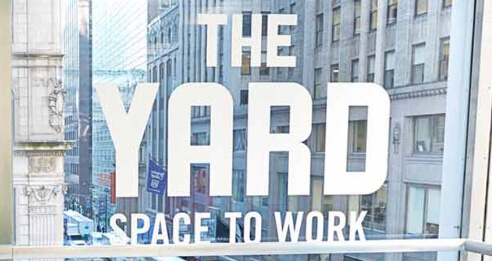
Largest Coworking Companies


The new decade began with several apocalyptic signs of climate change. Wildfires in Australia have devastated an area of land the size of Belgium and Denmark combined. Glaciers and ice caps are retreating and the pace is accelerating quickly. Bears can’t hibernate because it’s not cold enough. Scientists say that to remain at safe levels of atmospheric carbon, we’ll need to lower our emissions by 7.6% yearly.
So what does this have to do with coworking?
Your space—yes, your space—needs to take action. It requires an examination of your practices and a commitment to making some real changes. However, once you take the first steps and adjust your thinking, most of the changes are easily applied and have tangible benefits that your members, and the planet, will appreciate.
Do you know how much carbon is emitted to create the furniture, construction materials, and electronics you buy? And how much is emitted from the landfills that the discarded products end up in?
Landfills are the third largest source of U.S. carbon (and other greenhouse gas) emissions. When you make any purchase, but especially items in bulk, think about the waste you’re generating on both ends of the equation. Packaging, raw materials, production, and transportation all make up the true environmental cost of the new goods. And what are you doing with the old goods that you’re replacing? Try to find a new home for them, or better yet, see if you can just make do without the new items in the first place.
When we learned to "Reduce, Re-use, and Recycle," their importance is in that order. We often think that buying something new will fix a problem we have, when most often, products are band-aids rather than medicine.
Another major source of carbon emissions is from the global agricultural system, whether the production, transportation, or disposal. This is another area where you might not even have considered your space’s impact.
One of the miracles of the modern world is that consumers can buy non-seasonal foods and non-local produce year-round. But that convenience has a cost. Here in Berlin, we can get avocados in February. What does it take for that to happen? They are grown across an ocean, packed onto transport ships, and then driven to the grocery store. And to think that some even get thrown out because shoppers bought too many? That’s crazy. Don’t get caught up in the cycle of over-purchasing and waste.
So what can you do? Work with your local community! Buy seasonal produce, locally-grown food, and move down the food chain. The more energy that goes into producing something, the less sustainable it is. That’s part of why beef is so terrible for the planet, they are roughly 2% energy efficient, compared with pork’s 8.6% efficiency and poultry’s 13%. Many coworking spaces offer complimentary fruits, vegetables, and other food items. Pay attention to where you get your offerings and how you can reduce their impact.
You’ve probably already thought of this one. How you get electricity, and how much you use, has a direct impact on the climate. But as you also must know, getting new lightbulbs isn’t nearly enough.
It's become more necessary to work with the climate, not against it. In the United States, many businesses love to use AC on the first warm day and blast the heating on the first cold day, making inside temperatures stable whether it’s midnight in mid-February or noon in August. This is a luxury, but it’s both expensive and terrible for the planet, at least as far as modern technologies go.
Take ownership of your energy usage! Technology exists to solve the problem of wasteful energy consumption; find the right combination of sensors, automated systems, and optimized infrastructure to ensure that you aren’t heating empty rooms or leaving windows open while the AC is on. The data shows that not only are green renovations and improvements good for your carbon footprint, but for your profitability. According to the US Green Building Council:
Green buildings reduce day-to-day costs year-over-year. LEED buildings have reported almost 20 percent lower maintenance costs than typical commercial buildings, and green building retrofits typically decrease operation costs by almost 10 percent in just one year.
There’s some old-fashioned technology that can accomplish similar goals. Curtains in the summer, as well as window plants and reflective elements near the windows can dramatically cool your space when you need it; better insulation will keep your space cooler in the summer and warmer in the winter; and an efficient, well-maintained HVAC system will keep the air comfortable without sacrificing efficiency.
A space that has quietly, but confidently, taken initiative is Porto i/o in Porto, Portugal.
To reduce waste, they began to negotiate for less plastic in their deliveries and eliminated devices that require single-use inputs (coffee machine pods, for example).
Then they took aim at their energy supply. They talked with their supply company to negotiate using only renewably-sourced energy. This can be more difficult outside of Portugal. But other steps can be replicated by anyone.
They completely swapped out every inefficient energy device in their space. They set up solar panels and other energy-generating appliances. And they made a push in their space to get their members thinking about, and practicing sustainable actions.
When I spoke with Nuno Veloso, Co-founder and leader at Porto.io, about the ways that others can replicate their successes:
If you are looking for a checklist - there isn’t. Build your own, according to your needs, principles and goals. If I was to point out a good starting point, it would be Ivon Chouinard’s book “Tools for Grassroots Activists”. But never, ever forget to weigh in several factors besides the environmental one, such as the social, the economic and the cultural.
Social acceptance will be the final, decisive factor in your success. All the good intentions and energy in the world won’t make a difference in the profitability or efficiency of your space if you are indifferent towards the needs and interests of the community you serve. Your members need to understand why you’re taking these steps, how they can help, and what their next steps should be.
We tend to think of fighting climate change as an individual effort. But really, it’s a collective one. And if you run a coworking space, you have access to impact a small, but nonetheless meaningful, piece of collective action. Make it easy for your members to live and act sustainably. Partner with a local bike shop to offer discounts to your members. Run workshops on sustainability. Discover what works for your space and your members—you’ll find that your efforts are rewarded!
Save your community manager 41 hours each week—learn how The Yard did it with cloud-based access control.
Read the Case StudyThe Guide to Make Your Space More Profitable
Including interviews with experts and consultants.
Download GuideFree access to our best guides, industry insights and more.
